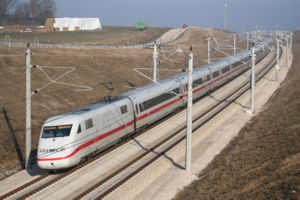ICE 2
| ICE 2 | |
|---|---|

ICE 2 on the Nuremberg-Ingolstadt high-speed railway line
|
|
| Manufacturer | Adtranz, Siemens |
| Constructed | 1995 to 1997 |
| Refurbishment | 2010 to 2013 |
| Number built | 46 |
| Formation | 1 power cars, 7 intermediate cars |
| Fleet numbers | Tz 201 to 244 |
| Capacity | 391 seats |
| Operator(s) | DB Fernverkehr |
| Depot(s) | Berlin-Rummelsburg |
| Specifications | |
| Maximum speed | 174 mph (280 km/h) |
| Weight | 412 t (405 long tons; 454 short tons) |
| Power output | 4,800 kW (6,400 hp) |
| Electric system(s) | 15 kV 16.7 Hz AC catenary |
| Current collection method | Pantograph |
| Safety system(s) | Sifa, PZB90, LZB |
| Track gauge | 1,435 mm (4 ft 8 1⁄2 in) standard gauge |
The ICE 2 is the second series of German high-speed trains and one of six in the Intercity-Express family since 1995.
The ICE 2 (half-)trains are even closer to a conventional push-pull train than the ICE 1, because each train consists of only one power car (Class 402, called powerhead), six passenger cars (Classes 805 to 807) and a cab car (Class 808).
Except for the automatic coupling, ICE 2 powerheads are very similar to those of the ICE 1 and can actually be used in ICE 1 trains if the necessity arrises.
Usually two ICE 2 half-trains are coupled to form a block train of similar dimensions to the original ICE 1 for serving the main routes, and separated again to operate on routes with less traffic or to provide the passengers two different destinations.
Until the class 808 cab cars have been tested and cleared for passenger service, two ICE 2 half-trains had been solidly coupled to form a permanent block train.
The passenger cars are very different from the ICE 1 cars, despite their similar exterior: The weight has been significantly reduced and the passenger compartments have been removed in favor of a seating arrangement similar to an airliner (due to reduced seat pitch). Also, the train has been equipped with air suspension to circumvent the wheel noise problems of the ICE 1, which led to the installation of rubber-buffered wheel rims on the ICE 1 units and therefore the Eschede train disaster.
ICE 2 trains have no service car as the class 803 on ICE 1 trains, on the other hand the class 808 cab car is unique to the ICE 2.
ICE 2 trains usually run on the main east-west line, starting in Berlin with two unit block train. In Hamm the train is separated into two half-trains.
One half-train goes through the Ruhr area to Cologne Bonn Airport, while the other half-train continues through Wuppertal and Cologne to Bonn. In the opposite direction, both half-trains are coupled again at Hamm.
...
Wikipedia
